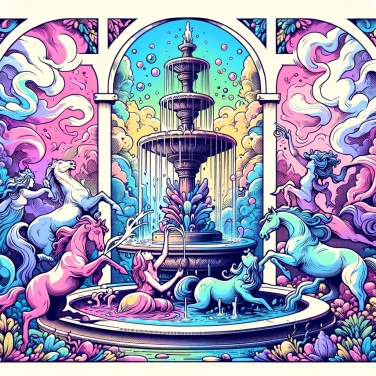The Fountain of Youth was supposed to make people immortal because it was associated with regenerative and rejuvenating properties, symbolizing eternal youth and longevity.

The Fountain of Youth has its origins in various ancient mythologies, particularly those related to beliefs about miraculous water. The oldest legend dates back to Mesopotamian mythology, where the epic of Gilgamesh mentions water that allows one to regain eternal youth. In ancient Greece, there were also similar tales of sacred springs capable of healing, rejuvenating, or even granting immortality to those who drank from them. Such legends were often linked to the idea of spiritual as well as physical purification, making these springs highly sought-after mythical places. The stories evolved and were passed down from one civilization to another, blending religious symbols and human fantasies surrounding the fear of aging and the desire for immortality.
For a very long time, humans have seen water as a miracle ingredient capable of healing the body and restoring youth. In ancient Greece, for example, sacred springs were believed to restore vigor and health to the sick. In other cultures, it was also believed that certain special waters, imbued with divine power, could purify the body and help people live much longer, even reach immortality. The fact that water is essential to all life likely explains why it has become a symbol of physical and spiritual regeneration. For many peoples around the world, immersing oneself in these magical waters was akin to starting anew and significantly extending one's lifespan.
The search for the fountain of youth seriously stirred European explorers from the 16th century onwards. One of the most famous, the Spaniard Juan Ponce de León, set out in search of it in 1513. His thing was North America: it is often thought that he landed in Florida just to find this famous miraculous water source. In reality, this story has probably been somewhat exaggerated by his contemporaries. But it fits perfectly with the context of the time, where each explorer hoped to stumble upon incredible riches or mystical powers. Many of these accounts were based on the writings of previous explorers and native legends, and sparked costly and inevitably disappointing expeditions.
The most famous name when talking about the Fountain of Youth is undoubtedly that of Juan Ponce de León. This Spanish explorer, who set out in the 16th century in search of gold and glory in the Caribbean and Florida, is also believed to have hoped to find the famous miraculous fountain. Even though today many think that it is mainly a legend later attached to his story, the myth has long been associated with him. Sometimes, Alexander the Great is also mentioned, as he was said to be obsessed with the quest for a spring capable of granting him eternal life. In medieval literature and some ancient Arabic tales, he is linked to similar searches, straddling the line between myth and reality.
The fountain of youth mainly symbolizes the deep human desire to overcome the fear of death and aging. It is a vivid image representative of our eternal quest for vitality and renewal. Today, this myth also sheds light on our contemporary fascination with rejuvenation, particularly evident in the success of the anti-aging cosmetics industry and scientific research on regenerative medicine and the fight against senescence. Whether modern or ancient, the dream remains similar: to push our biological limits to experience a form of immortality, whether real or symbolic.
Today, the fountain of youth still inspires modern science. Researchers are working on anti-aging treatments based on natural ingredients found in certain thermal waters, thus reflecting the enduring connection between this myth and the real quest for greater human longevity.
The name Florida comes from the Spanish word 'Florida,' meaning 'flowery,' because the explorer Ponce de León discovered this region in the spring during his quest for the famous fountain of youth.
The legend of the fountain of youth appears in various forms in mythologies around the world, particularly in Chinese mythology with the peaches of immortality consumed by Taoist deities.
In certain ancient civilizations, such as that of the Egyptians, water was regarded not only as a source of life but also as a central element for spiritual purification and a complete regeneration of the human body.
The Fountain of Youth is often used symbolically to represent the human hope of escaping aging or mortality. In literature and the arts, it expresses dreams of renewal, rebirth, and the eternal aspiration for youth.
The most famous figure is the Spanish explorer Juan Ponce de León, who is said to have searched for this fountain in the 16th century, particularly in Florida. However, contemporary historians claim that this quest was mainly attributed to him later on by subsequent accounts.
In ancient times, water was regarded as a pure source capable of cleansing, purifying, and renewing life. Its symbolic power extended to physical and spiritual healing, naturally giving rise to beliefs surrounding water as the key to regeneration or immortality.
Yes, several natural springs are still claimed to be miraculous by certain communities. For example, some thermal or mineral springs are valued for their supposed therapeutic properties, although their exact effectiveness remains largely unproven scientifically.
No, there is no confirmed historical evidence demonstrating the actual existence of this fountain. The myth originates from ancient and medieval accounts, often exaggerated or linked to misinterpreted natural discoveries.

No one has answered this quiz yet, be the first!' :-)
Question 1/5